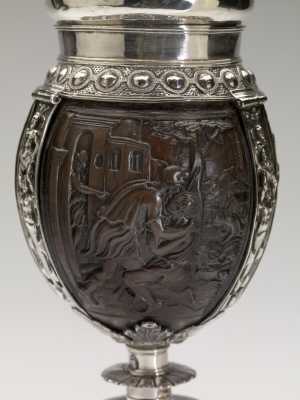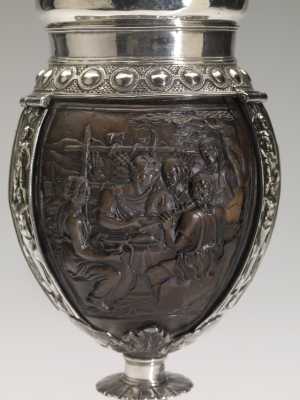In the 16th century, the coconut was not only prized for its rarity and exotic origins, but also because of its supposed medicinal and protective qualities.
Three scenes have been carved into this coconut; they are based on prints by Hans Sebald Beham (1500-1550). The scenes are from the story of the Prodigal Son (Luke 15: 11-32). They show the Prodigal Son leaving his parental house, his life squandering his inheritance, and his return home.
A silver smith then placed the coconut in a silver mounting, and transformed it into this display goblet. This collector's item reflects the style of Antwerp masters such as Frans Floris I (de Vriendt).

Specifications
| Title | coconut goblet |
|---|---|
| Material and technique | Coconut with cut scene, zilver |
| Object type |
Coconut goblet
> Beaker
> Tableware
> Kitchen and household
> Utensil
|
| Location | This object is in storage |
| Dimensions |
Height 23,7 cm Diameter 9 cm |
|---|---|
| Artists |
Goldsmith:
Anoniem
|
| Accession number | MBZ 243 (KN&V) |
| Credits | Purchased 1969 |
| Department | Applied Arts & Design |
| Acquisition date | 1969 |
| Creation date | in 1550 - 1600 |
| Internal exhibitions |
Hand Made - Long Live Craft (2013) |
| External exhibitions |
Boijmans bij de Buren - REMIX ROTTERDAM, Boijmans X Wereldmuseum (2020) |
| Research |
Show research Alma |
| Material | |
| Object | |
| Geographical origin | Belgium > Western Europe > Europe |



























